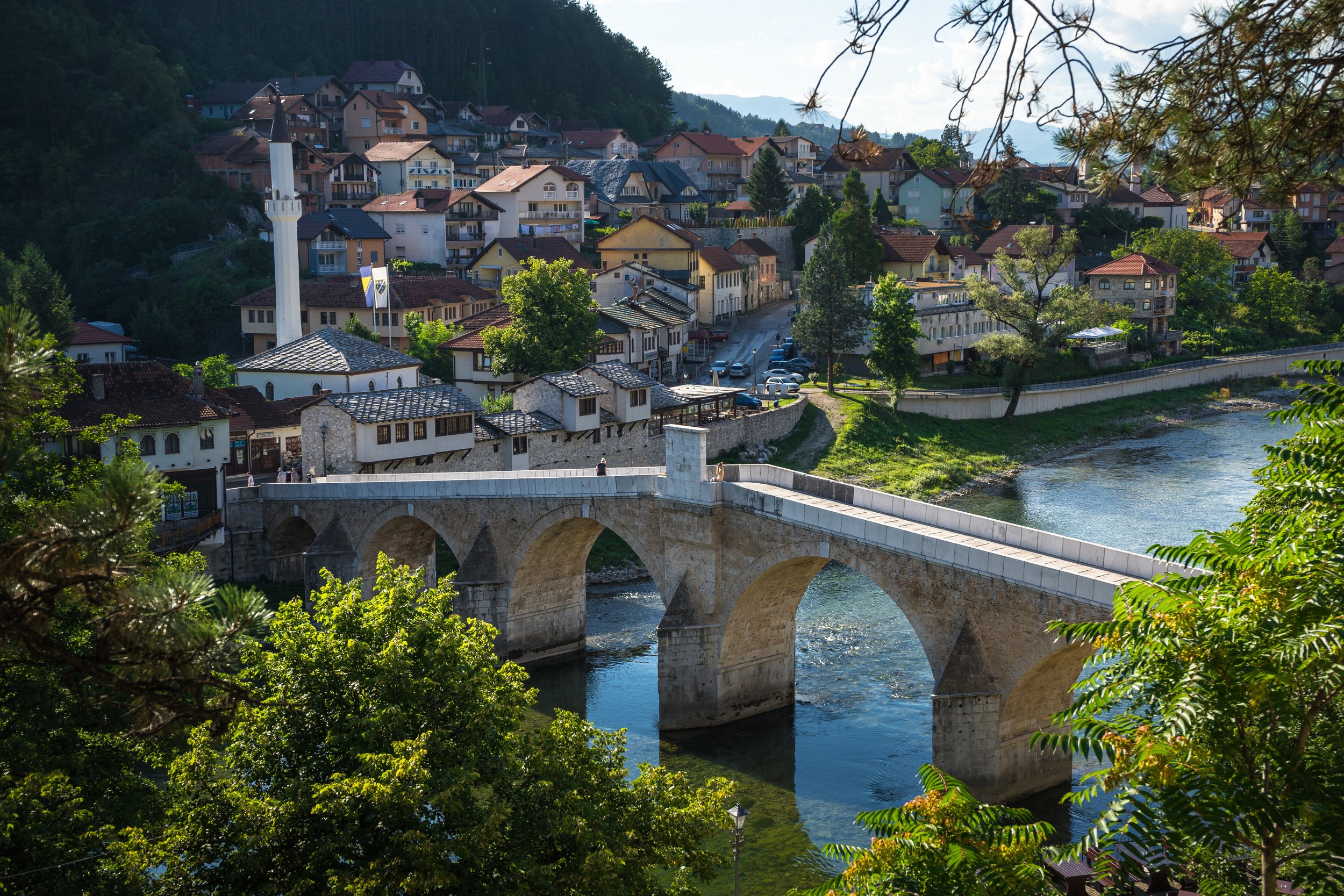Konjic // A Bridge, A Museum, A Beatle
© marketa1982 // Shutterstock.com
The entire visit took about 20 minutes. I didn’t rush either, far from it. I studied every single photograph of the famous bridge, the Stara Ćuprija, constructed in 1683 under the watchful eye of Ali-aga Hasečić. The story of Ali-aga Hasečić isn’t too important here. He was a dignitary from the Ottoman capital who was sent here to fix stuff up. I’ve referred to the bridge as the ‘George Harrison of Bosnia and Herzegovina’s Ottoman-era stone bridges’ on a number of occasions without really knowing what that means. I know more about Ottoman-era stone bridges than I do about the Beatles.
Again, none of this is important, but I studied each of the pictures nonetheless. A small exhibition of the life and times of Pero Mužijević, a Bohemian who loved literature, Renaissance culture and the like. The keyword is small, of course.
The upper room of the museum was filled with the usual ethnographic artefacts and models, showcasing the hardy life of people in the hills of Konjic from back in the day until the modern era. If you’ve never been to an ethnographic museum in Bosnia and Herzegovina, it would be an interesting visit. Alas, I have been to almost all of the ethnographic museums in Bosnia and Herzegovina.
© ﹏﹏﹏﹏﹏ // Shutterstock.com
All of which isn’t really fair, because the city museum of Konjic is not the main pull of this darling city, the place where Bosnia kisses Herzegovina. There is something about Konjic that really clicks. The gorgeous location absolutely plays its part, a city surrounded by mountains that gives the stunning Neretva free reign to run through its heart, with the Stara Ćuprija acting as a most graceful artery. I’m not sure if that is how hearts work, but I’m sticking with it.
Besides, the poise of the Stara Ćuprija allows it to stand out from the other stone bridges of Bosnia and Herzegovina, in the same way that George Harrison’s dry wit and commitment to credibility helped him stand out from the other Beatles. Yeah, I had to do some research for that, but there we go. British archaeologist (pfft) Arthur John Evans, in his journey through the country on foot in 1875, referred to it as “a long and handsome bridge, the finest of those seen so far”, although he also referred to the town as Coinica. Win some, lose some. Evans also referred to Konjic (well, Coinica) as the ‘Runnymede of Bosnia’ and the ‘Key to Herzegovina’, almost as if he was trying to happen upon a nickname that might stick. The George Harrison of Bosnia and Herzegovina was right in front of you, Arthur! Damn archaeologists!
People had been coming to Konjic long before the Knossos excavator wandered in. After all, where there is a river, there tends to be life, and this place is no different. By the 15th century, the many caravan stations in the Neretva valley were gaining traction as trade grew between Dubrovnik (Ragusa) and central Bosnia, and one important customs house was erected in Konjic. The Ottomans conquered the place in 1463, and their documents refer to it as a market, but they soon set about developing into a communications hub, and no communications hub is complete without a sweet stone bridge crossing the shimmering river.
The first bridge across the Neretva in Konjic was constructed in the years before, ostensibly by Mehmed-beg Karadjoz, the same chap who helped build his eponymous mosque in the heart of Mostar. Eat at Saray, people. It was a wooden bridge, some 20 metres downstream from where the current beauty lies, although the whole ‘wooden’ thing meant it was somewhat fragile. Something more solid was needed. Enter George Harrison.
© AleksandarPhotography // Shutterstock.com
There isn’t much information available about the history of the Stara Ćuprija, although expecting there to be would be somewhat naive. After all, what is the reality of a functioning bridge? There is little interest to be found in day-to-day existence, and warts and all accounts of the Stara Ćuprija would amount to a ledger of people paying a toll and the energetic gossip of those who passed. The history of bridges doesn’t lend itself to events outside of construction and destruction.
The latter came in the dying days of World War II when the German army blew it up in order to stop the onrushing Partisans from further closing the gap. A replacement structure was thrust up after the war, soon replaced by a reinforced concrete one. By the time the 21st century arrived, the calls for rebuilding the original Stara Ćuprija were too loud to ignore, and the beauty was finally unveiled in 2009.
And still, it stands, in its own languid sort of fashion. The terrace at Hotel Konak was a lovely place to sit and gawp at the bridge’s poise, but a somewhat noisy family had decided it was okay to open a window and feed a dog, leading to much shouting from the kids and much barking from the dogs, not to mention a brutal chill that seemed to find me particularly inviting. I left, passed the museum once more and crossed the bridge, stopping to consider the energetic Neretva. Behind me, I saw another dog had joined the feeding frenzy at the window.


